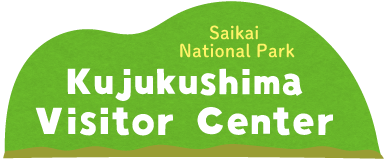Kujukushima boasts some of the most scenic coastal areas in the country. The natural coastlines of the islands and Kyushu mainland are also important ecosystems that support a wide range of plants and wildlife, including a number of rare and endangered species. The sandy beaches and lagoons of Kujukushima are home to creatures like the horseshoe crab (Tachypleus tridentatus), often referred to as a living fossil. While horseshoe crab populations have decreased significantly in many areas of Asia, a large number come to spawn along the Kujukushima coastline.
In muddier areas, visitors may come across the air-breathing sea slug (Onchidium hongkongensis), which is nearly extinct on the four main islands of Japan, as is the tiny white clam Anomalocardia squamosa. Rare crustaceans, like the milky fiddler crab (Uca lactea) and dotillid crab (Ilyoplax pusilla), also scurry along the shoreline.
Kujukushima is an important environment for rare and endangered plants as well, including Japanese sedge (Carex kobomugi) and dwarf sedge (Carex pumila), which grow in sandy areas and are instrumental in stabilizing dunes.
Besides these examples, hundreds of species of fish, birds, mammals, mollusks, flowers, and plants live along these pristine shores. Because of their presence, Kujukushima’s coastlines offer exciting spots for nature lovers.
<PHOTOS>
1,Most of the beaches in the Kujukushima group are natural and free of man-made features.
2,The pristine coastline is an important ecosystem that supports a large number of animal and plant species.
3,The natural beaches are dotted with plants, including herbaceous seepweed (Suaeda maritima) and autumn statice (Limonium tetragonum), both salt marsh dwellers.
4,Landfill and seawall construction endanger salt marshes around Japan.
5,The Kujukushima area has a large variety of natural beaches, including sand beaches, rocky shorelines, and mudflats.
Getting a good view of all these little islands from sea level is difficult. To get a sense of the full scale of Kujukushima, we recommend visiting one of the observatories in Sasebo. From these high vantage points, visitors will see hundreds of islets stretching out into the distance. From large tree-covered islands to tiny dots of green and rock, the islands come in every size and shape. On clear days visitors may be able to make out the Goto Islands to the west, another island chain that is part of Saikai National Park.
<PHOTOS>
6,The islands are counted during the highest tide of the year.
7,Any island that remains above the highest tide and can support plant life is included in the count.
8,The presence of terrestrial plants indicates that the island is not submerged at high tide.
Traditional methods of fishing are still practiced here, with many fishermen still using old-fashioned nets, baited lines and traps, and other methods. Aquaculture is also a thriving industry, especially for oysters, a special local delicacy.
It is common to see boats of oyster farmers tending to the mollusks, either scrubbing the shells of juveniles or pulling up long chains of mature oysters. Of course, oysters create pearls, and pearl cultivation is another local industry. Since the early twentieth century, Akoya pearl oysters (Pinctada fucata) have been artificially seeded by hand, starting the production of perfectly shaped and colored pearls.
Visitors interested in seeing Kujukushima from a fisherman’s perspective can join a boat tour around the islands. The excursion boats, which resemble square-rigged European sailing ships, depart several times a day from a pier close to the Visitor Center.
<PHOTOS>
9,An excursion boat passes behind an oyster farmer working an aquaculture net.
10,Throughout the islands, there are fixed nets that catch fish moving through the area.
11,An example of seine fishing. Large hauls of horse mackerel and sardines are caught in the seas just off Kujukushima.
12,People in this area have relied on local fish for their diet for centuries.
13,Ikashiba, a traditional method of squid fishing. Fishermen use tree branches, which squid mistake for seaweed beds, to attract spawning squid into a trap net.
The islands north of the river mouth were formed relatively recently, while the southern islands are about 10 million years older. The age of the islands can be estimated from their shape and structure. The northern islands have a gentle shape, while those to the south have much steeper terrain, and are smaller and more numerous.
<PHOTO>
14,Island to the north of the Sazagawa River
15,Island in the southern area
16,Sazagawa River
17,Northern Kujukushima islands
18,Southern Kujukushima islands
For example, a 2000 survey of the uninhabited island of Tokoi uncovered the presence of a flowering vine called tobikazura (Mucuna sempervirens). While this protected purple-flowered plant is found across southwestern China, this is the first time it was found growing wild in Japan. How the vine came to thrive here is still a mystery—theories include continental drift, seeds floating in from China, or being brought in by humans.
<PHOTOS>
19,Discovery of Tobikazura
This rare flowering plant blooms in natural wooded settings, and was found during a botanical survey of Tokoi Island.
20,Examining Flowering Lilium speciosum
A regular investigation of this member of the lily family, known as kanoko yuri in Japanese.
21,Survey of Ocean-Dwelling Water Striders
Researchers are studying two species of endangered ocean water striders in the Kujukushima islands: shio amenbo (Halovelia septentrionalis Esaki) and shio umiamenbo (Halobates japonicus). The insect is the mascot of the Visitor Center; a large stuffed umiamenbo is on display above the front desk.
22,Water Quality Check
The water is checked twice a month to keep an eye on temperature, clarity, and any changes.
23,Ice Goby Spawning Survey
The ice goby, or shirouo (Leucopsarion petersii) is an important seasonal food fish. It can even spawn in the small rivers that run through some of the islands of Kujukushima.
24,Survey of Ocean Vegetation
Specialists and volunteers join forces to survey the distribution of the many forms of ocean vegetation found in Kujukushima.

















